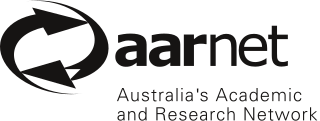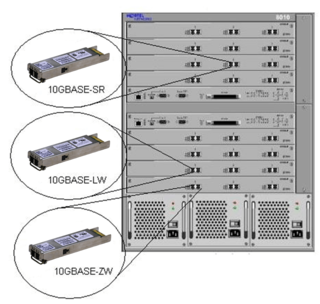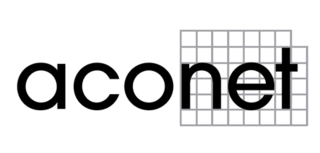
A metropolitan area network (MAN) is a computer network that interconnects users with computer resources in a geographic region of the size of a metropolitan area. The term MAN is applied to the interconnection of local area networks (LANs) in a city into a single larger network which may then also offer efficient connection to a wide area network. The term is also used to describe the interconnection of several LANs in a metropolitan area through the use of point-to-point connections between them.

The London Internet Exchange ("LINX") is a mutually governed Internet exchange point (IXP) that provides peering services and public policy representation to network operators. It was founded in 1994 in London. LINX operates IXPs in London, Manchester, Scotland and Wales in the United Kingdom and Northern Virginia in the United States.

Small Form-factor Pluggable (SFP) is a compact, hot-pluggable network interface module format used for both telecommunication and data communications applications. An SFP interface on networking hardware is a modular slot for a media-specific transceiver, such as for a fiber-optic cable or a copper cable. The advantage of using SFPs compared to fixed interfaces is that individual ports can be equipped with different types of transceivers as required, with the majority including optical line terminals, network cards, switches and routers.

AARNet provides Internet services to the Australian education and research communities and their research partners.

The Amsterdam Internet Exchange (AMS-IX) is an Internet exchange point based in Amsterdam, in the Netherlands. Established in the early 1990s, AMS-IX is a non-profit, neutral and independent peering point.

A passive optical network (PON) is a fiber-optic telecommunications technology for delivering broadband network access to end-customers. Its architecture implements a point-to-multipoint topology in which a single optical fiber serves multiple endpoints by using unpowered (passive) fiber optic splitters to divide the fiber bandwidth among the endpoints. Passive optical networks are often referred to as the last mile between an Internet service provider (ISP) and its customers. Many fiber ISPs prefer this technology.

The Toronto Internet Exchange Community (TorIX) is a not-for-profit Internet Exchange Point (IXP) located in a carrier hotel at 151 Front Street West, Equinix's TR2 data centre at 45 Parliament Street and 905 King Street West in Toronto, Ontario, Canada. As of March 2021, TorIX has 259 unique autonomous systems representing 285 peer connections and peak traffic rates of 1.344 Tbps, making it the largest IXP in Canada. According to Wikipedia's List of Internet Exchange Points by Size, TorIX is the 16th largest IXP in the world in numbers of peers, and 17th in the world in traffic averages. The Exchange is organized and run by industry professionals in voluntary capacity.

The IBM BladeCenter was IBM's blade server architecture, until it was replaced by Flex System in 2012. The x86 division was later sold to Lenovo in 2014.

The physical-layer specifications of the Ethernet family of computer network standards are published by the Institute of Electrical and Electronics Engineers (IEEE), which defines the electrical or optical properties and the transfer speed of the physical connection between a device and the network or between network devices. It is complemented by the MAC layer and the logical link layer. An implementation of a specific physical layer is commonly referred to as PHY.
40 Gigabit Ethernet (40GbE) and 100 Gigabit Ethernet (100GbE) are groups of computer networking technologies for transmitting Ethernet frames at rates of 40 and 100 gigabits per second (Gbit/s), respectively. These technologies offer significantly higher speeds than 10 Gigabit Ethernet. The technology was first defined by the IEEE 802.3ba-2010 standard and later by the 802.3bg-2011, 802.3bj-2014, 802.3bm-2015, and 802.3cd-2018 standards. The first succeeding Terabit Ethernet specifications were approved in 2017.
The current portfolio of PowerConnect switches are now being offered as part of the Dell Networking brand: information on this page is an overview of all current and past PowerConnect switches as per August 2013, but any updates on current portfolio will be detailed on the Dell Networking page.

DE-CIX is an operator of carrier- and data-center-neutral Internet Exchanges, with operations in Europe, North America, Africa, the Middle East, India and Southeast Asia. All DE-CIX activities and companies are brought together under the umbrella of the DE-CIX Group AG.

The Atlanta Internet Exchange (AtlantaIX) is an Internet Exchange Point situated in Atlanta, Georgia, United States. AtlantaIX is a fast-growing, neutral and independent peering point. The beginnings of the AtlantaIX can be traced back to 1997. The current version of the AtlantaIX was re-established on September 4, 2003 by Michael Lucking, GreatAccess.com, WV Fiber and 56 Marietta Street Partners. AtlantaIX was originally created as a free exchange point sponsored by the donations of the founders. Today AtlantaIX continues to run without any re-occurring charges to the participants. In 2007, one time port fees were instituted to aid in paying for a recently upgraded switch infrastructure. In January 2007, Michael Lucking purchased a new Foundry Networks Jetcore 15000 in order to support 10 Gigabit Ethernet connections. In January 2008 the switch fabric was migrated to a Cisco 6509 in order to support line rate 10 gigabit Ethernet. In early 2008, the AtlantaIX began supporting IPv6.

The Seattle Internet Exchange (SIX) is an Internet exchange point in Seattle, USA. Its switch fabric is centered at the Westin Building and extended to KOMO Plaza, Sabey Intergate, and other locations. The SIX is one of the most successful examples of neutral and independent peering points, created as a free exchange point originally sponsored only by donations. The SIX is the most frequently cited model upon which other neutral Internet exchanges are based, and its financial and governance models are often cited as inspiration for other exchanges. It continues to run without any recurring charges to the participants and current major funding comes from one-time 10, 100, and 400 Gbit/s port fees, as well as from voluntary contributions from stakeholders. The SIX is a 501(c)(6) tax-exempt non-profit corporation.
Juniper E-Series is a series of broadband services routers or edge routers manufactured by Juniper Networks. The E series was originally developed by Unisphere Networks, which Juniper acquired in 2002. These routers provide multiple services including broadband remote access server, broadband video services, dedicated access, 802.11 wireless subscriber management, VOIP, internet access, security services, network address translation (NAT) etc. on a single platform. The carrier-class architecture of E-series routers allows to combine Broadband Remote Access Server (B-RAS) and dedicated access capabilities on a single and integrated platform. The E-series routes runs on JUNOSe software compared to other series of routers of Juniper which runs on JUNOS.

10 Gigabit Ethernet is a group of computer networking technologies for transmitting Ethernet frames at a rate of 10 gigabits per second. It was first defined by the IEEE 802.3ae-2002 standard. Unlike previous Ethernet standards, 10GbE defines only full-duplex point-to-point links which are generally connected by network switches; shared-medium CSMA/CD operation has not been carried over from the previous generations of Ethernet standards so half-duplex operation and repeater hubs do not exist in 10GbE. The first standard for faster 100 Gigabit Ethernet links was approved in 2010.
10G-PON is a 2010 computer networking standard for data links, capable of delivering shared Internet access rates up to 10 Gbit/s over existing dark fiber. This is the ITU-T's next generation standard following on from GPON or Gigabit-capable PON. Optical fibre is shared by many subscribers in a network known as FTTx in a way that centralises most of the telecommunications equipment, often displacing copper phone lines that connect premises to the phone exchange. Passive optical network (PON) architecture has become a cost-effective way to meet performance demands in access networks, and sometimes also in large optical local networks for "Fibre-to-the-desk".
Dell Networking is the name for the networking portfolio of Dell. In the first half of 2013, Dell started to rebrand their different existing networking product brands to Dell Networking. Dell Networking is the name for the networking equipment that was known as Dell PowerConnect, as well as the Force10 portfolio.

ACOnet is the name of the national research and education network in Austria. The ACONET association promotes the development and use of that network. ACOnet is not managed and operated by ACONET, but by a unit in the Computing Centre of the University of Vienna that also operates the Vienna Internet Exchange. The University of Vienna represents ACOnet internationally, for example as a member of TERENA and as a participant in the project that funds the European backbone network GÉANT.
UAE-IX is a carrier- and data center-neutral internet exchange point (IXP) situated in Dubai (UAE). It interconnects global networks, network operators and content providers in the GCC region. Founded in 2012, UAE-IX is built on a fully redundant switching platform located in two data centers in Dubai, Datamena and Equinix. Initiated by the UAE’s Telecommunication Regulatory Authority (TRA) and fully managed by DE-CIX, UAE-IX delivers a local alternative for regional traffic exchange, localizing Internet content.













